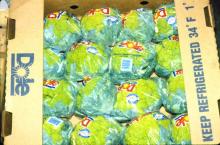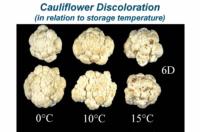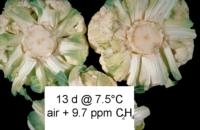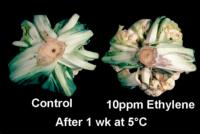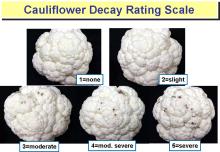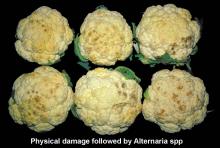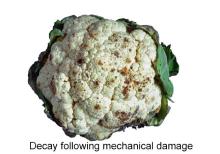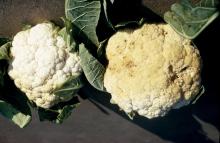Product Description
Indices de Maturité
La maturité des choux-fleurs est basée sur la taille et la compacité de la pomme (tête) ou inflorescence. Les pommes mûres ont un diamètre d’au moins 15 cm (6 pouces). L’existence de parties florales qui dépassent la pomme créant une apparence granuleuse est un signe de surmaturité. Les choux-fleurs sont emballés après avoir été coupés et mis dans des boîtes de carton de 12 ou 24 pommes, les boîtes de 12 étant plus communes.
Le chou-fleur est commercialisé avec des feuilles coupées à ras, et enveloppé avec un film perforé. Ce dernier doit avoir quatre à six trous (1/4 pouce) par pomme pour permettre une ventilation adéquate.
Une pomme ferme et compacte avec une inflorescence de couleur blanc crème entourée de feuilles vertes turgides bien coupées. Des indices additionnels de qualité sont la taille, l’absence de jaunissement sévère dû à l’exposition au soleil, l’absence de défauts de manutention et pourriture, et l’absence de l’apparence granuleuse.
Manipulation et stockage post-récolte
0°C (32°F)
Il est généralement recommandé que le stockage du chou-fleur ne dépasse pas les trois semaines pour garder une bonne qualité visuelle et sensorielle. L’incidence de flétrissement, brunissement, jaunissement des feuilles, et pourriture augmente après un stockage de 3 à 4 semaines à des températures supérieures à celles recommandées.
95-98%
| Température | 0°C (32) | 5°C (41) | 10°C (50°F) | 15°C (59°F) | 20°C (68°F) | 25°C (77°F) |
| ml CO2/kg·hr | 8-9 | 10-11 | 16-18 | 21-25 | 37-42 | 43-48 |
Pour calculer la production de chaleur, il faut multiplier ml CO2/kg·hr par 440 pour obtenir BTU/tonne (britannique)/jour ou par 122 pour avoir kcal/tonne (métrique)/jour.
<0,1 µl/kg·hr à 20°C (68°F)
Le choux-fleur est hautement sensible à l’éthylène de source exogène. Des concentrations non élevées en éthylène durant la distribution et le stockage à courte durée sont suffisantes pour accélérer la décoloration de l’inflorescence ainsi que le jaunissement et le détachement des tiges des feuilles. Ne pas stocker avec pommes, melons ou tomates.
Les atmosphères contrôlées ou modifiées offrent un avantage modéré à limité pour le chou-fleur. Des dégâts peuvent être causés par des atmosphères à taux d’O2 <2% ou taux de CO2>5%; ces dégâts peuvent ne pas être visibles sur le légume et n’apparaître qu’après la cuisson: l’inflorescence devient grisâtre, extrêmement douce au toucher et d’odeur indésirable. Des taux élevés de CO2 (>10%) causent ce dégât en 48 heures. Une combinaison de taux d’O2 bas et de taux de CO2 légèrement élevés (3-5%) retarde de quelques jours le jaunissement et le début du brunissement de l’inflorescence.
For fresh-cut applications, the sensitivity of cauliflower to improper modified atmosphere (See Responses to CA) demands very careful selection of packaging films and proper temperature management.
Physiological and Physical Disorders
Dégât dû au Gel. Initié à -0,8°C (30,6°F). Les symptômes incluent une inflorescence translucide et grisâtre et des feuilles translucides et flétries. L’inflorescence devient de couleur marron et d’apparence gélatineuse suite à une pourriture bactérienne molle.
La récolte doit être faite avec soin pour prévenir les dommages qui peuvent être causés à l’inflorescence turgide et très sensible. Le chou-fleur ne doit jamais être manipulé du côté de l’inflorescence. Les choux-fleurs ne doivent pas être laissés rouler ou traîner sur la courroie transporteuse, table ou autre surface de travail. Les meurtrissures sont très communes et causent le pourrissement et le brunissement rapide quand les bonnes pratiques de récolte et de manutention ne sont pas respectées.
Désordres
Les maladies sont d’importantes sources de pertes après récolte, surtout en cas de manutention brutale et mauvais contrôle de la température. Une longue liste d’agents pathogènes bactériens et fongiques causent les pertes après récolte durant le transit, stockage, et au niveau du consommateur. La pourriture bactérienne molle (essentiellement Erwinia and Pseudomonas), l’alternariose des crucifères (Alternaria alternata), la pourriture grise (Botrytis cinerea), et la cladosporiose (Cladosporium sp.) sont des désordres communs.
References
Des références provenant de sources scientifiquement validées seront ajoutées ultérieurement.




